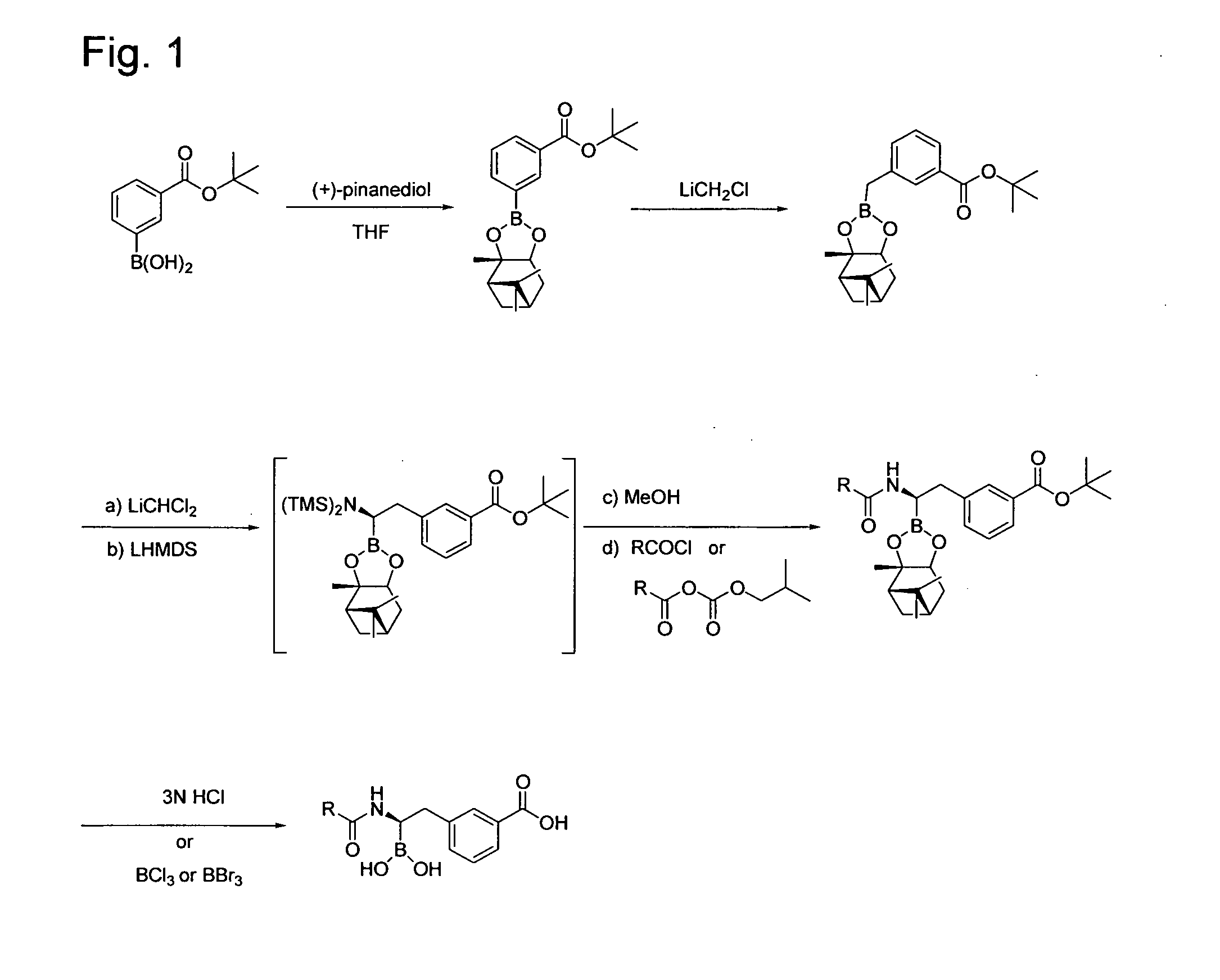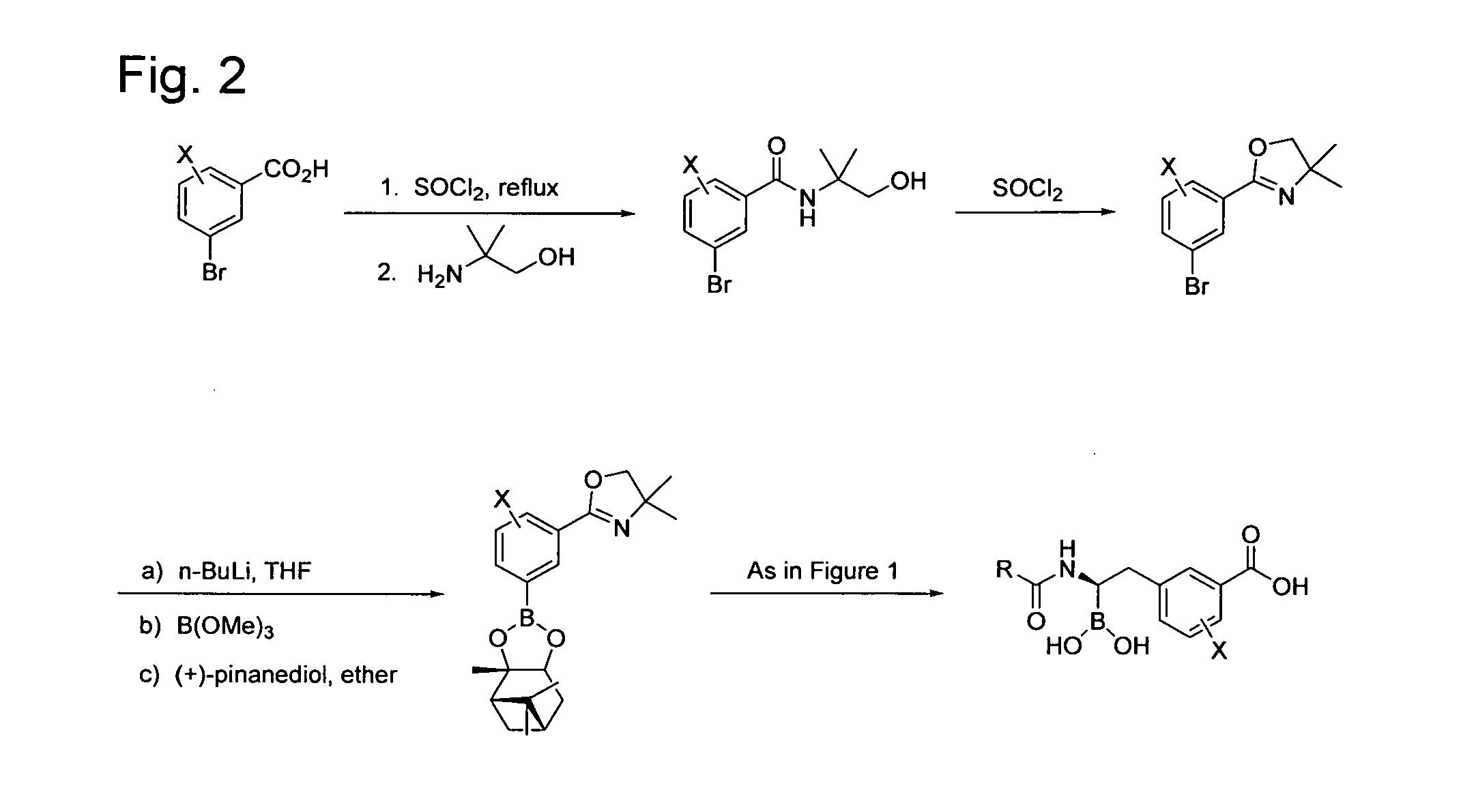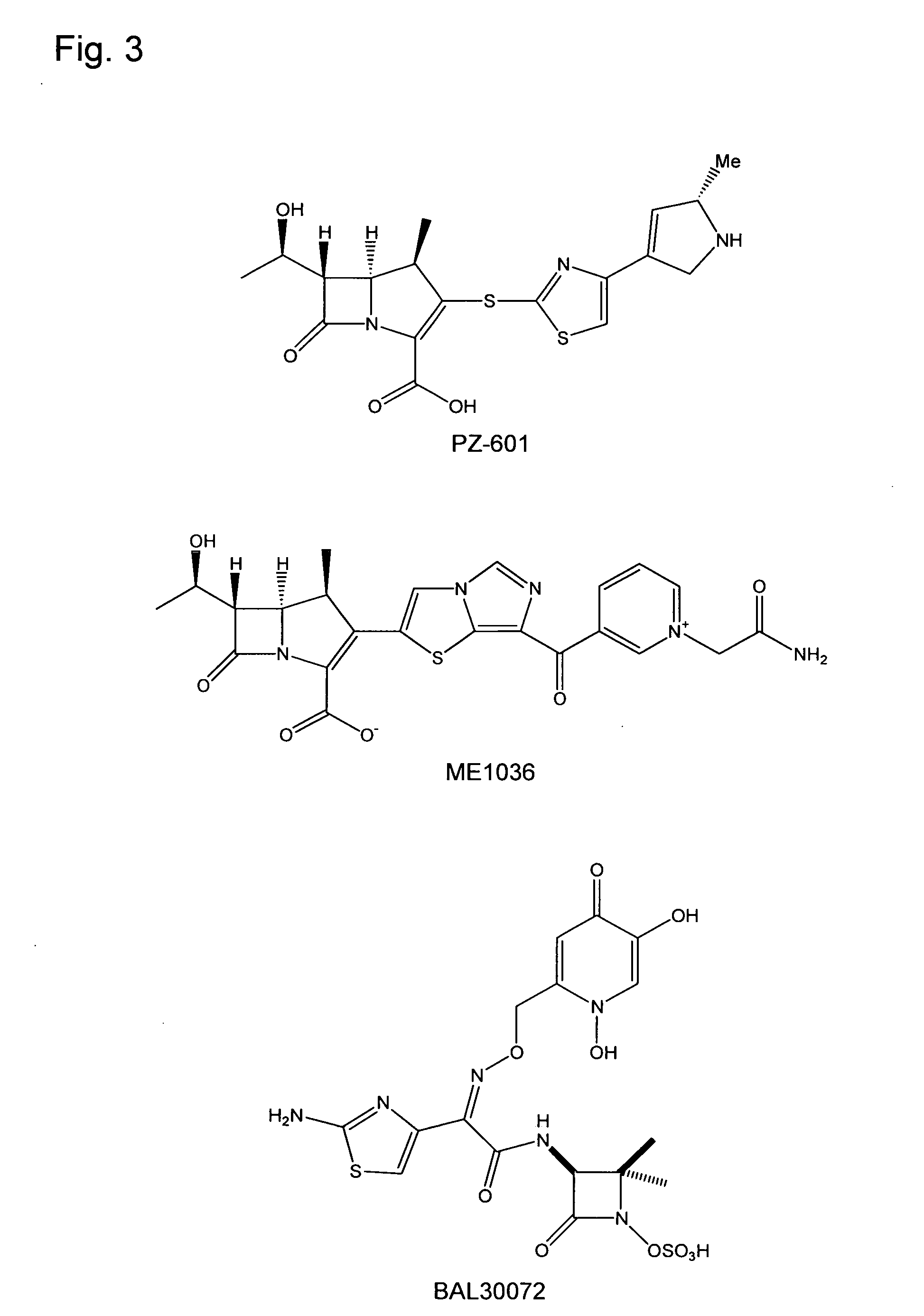Beta-lactamase inhibitors
a beta-lactamase and inhibitor technology, applied in the field of aminoboronic acids, can solve the problems of serious medical problems, limited beta-lactamase treatment options in the hospital and in the community, and diminishing utility
- Summary
- Abstract
- Description
- Claims
- Application Information
AI Technical Summary
Benefits of technology
Problems solved by technology
Method used
Image
Examples
example 1
(1R)-1-(2-thiophene-2-yl-acetylamino)-2-(3-carboxyphenyl)ethyl-1-boronic acid
[0280]Step 1. Synthesis of 3-(2,9,9-Trimethyl-3,5-dioxa-4-bora-tricyclo[6.1.1.02,6]dec-4-yl)-benzoic acid tert-butyl ester. A solution of (+)-pinanediol (10.0 g, 58.7 mmole) and 3-tert-Butoxycarbonylphenylboronic acid (13.0 g, 58.7 mmole) in tetrahydrofuran (THF, 78 mL) was stirred for 30 min at room temperature. The solution was concentrated in vacuo, and the residue chromatographed on SiO2 using a gradient of 20% dichloromethane (DCM) in hexane to 70% DCM / hexane to afford 17.76 g (85%) of the product as a slowly crystallizing white solid. Electrospray Ionization Mass Spectrum (ESI-MS) m / z 301 (MH−C4H9)+.
[0281]Step 2. Synthesis of 3-(2,9,9-Trimethyl-3,5-dioxa-4-bora-tricyclo[6.1.1.02,6]dec-4-ylmethyl)-benzoic acid tert-butyl ester. To a solution of 3-(2,9,9-trimethyl-3,5-dioxa-4-bora-tricyclo[6.1.1.02,6]dec-4-yl)-benzoic acid tert-butyl ester (6.0 g, 16.85 mmole) and chloroiodomethane (1.5 mL, 21.06 mmole)...
example 2
(1R)-1-(3-Methoxyphenylacetylamino)-2-(3-carboxyphenyl)ethyl-1-boronic acid
[0284]Step 1. Synthesis of 3-[2-[2-(3-Methoxy-phenyl)-acetylamino]-2-(2,9,9-trimethyl-3,5-dioxa-4-bora-tricyclo[6.1.1.02,6]dec-4-yl-ethyl]-benzoic acid tert-butyl ester. This was prepared from 3-(2,9,9-trimethyl-3,5-dioxa-4-bora-tricyclo[6.1.1.02,6]dec-4-ylmethyl)-benzoic acid tert-butyl ester and 3-methoxyphenylacetyl chloride following the procedure described in Step 3 of Example 1 except that the product was purified by chromatography on SiO2 using a gradient of 30% EtOAc / hexane to 60% EtOAC / hexane. The product was obtained as a yellow foam in 8% yield. ESI-MS m / z 548 (MH)+.
[0285]Step 2. Synthesis of (1R)-1-(3-Methoxyphenylacetylamino)-2-(3-carboxyphenyl)ethyl-1-boronic acid. A solution of 3-[2-[2-(3-methoxy-phenyl)-acetylamino]-2-(2,9,9-trimethyl-3,5-dioxa-4-bora-tricyclo[6.1.1.02,6]dec-4-yl)-ethyl]-benzoic acid tert-butyl ester (123 mg, 0.22 mmole) in 1 mL of 1,4-dioxane and 6 mL of 3N HCl was heated to ...
example 3
(1R)-1-(3-Chlorophenylacetylamino)-2-(3-carboxyphenyl)ethyl-1-boronic acid
[0286]Step 1. Synthesis of 3-chlorophenylacetyl chloride. A solution of 3-chlorophenylacetic acid (2.0 g) in 9 mL of thionyl chloride was refluxed for 1.5 h. The solution was cooled and concentrated in vacuo to afford the acid chloride as a yellow oil.
[0287]Step 2. Synthesis of 3-[2-[2-(3-Chloro-phenyl)-acetylamino]-2-(2,9,9-trimethyl-3,5-dioxa-4-bora-tricyclo[6.1.1.02,6]dec-4-yl)-ethyl]-benzoic acid tert-butyl ester. This was prepared from 3-(2,9,9-trimethyl-3,5-dioxa-4-bora-tricyclo[6.1.1.02,6]dec-4-ylmethyl)-benzoic acid tert-butyl ester as described in Step 1 of Example 2 using 3-chlorophenylacetyl chloride. ESI-MS m / z 552 (MH+), 574 (M+Na)+.
[0288]Step 3. Synthesis of (1R)-1-(3-Chlorophenylacetylamino)-2-(3-carboxyphenyl)ethyl-1-boronic acid. This was prepared from 3-[2-[2-(3-Chloro-phenyl)-acetylamino]-2-(2,9,9-trimethyl-3,5-dioxa-4-bora-tricyclo[6.1.1.02,6]dec-4-yl)-ethyl]-benzoic acid tert-butyl ester f...
PUM
| Property | Measurement | Unit |
|---|---|---|
| temperature | aaaaa | aaaaa |
| temperature | aaaaa | aaaaa |
| temperature | aaaaa | aaaaa |
Abstract
Description
Claims
Application Information
 Login to View More
Login to View More - R&D
- Intellectual Property
- Life Sciences
- Materials
- Tech Scout
- Unparalleled Data Quality
- Higher Quality Content
- 60% Fewer Hallucinations
Browse by: Latest US Patents, China's latest patents, Technical Efficacy Thesaurus, Application Domain, Technology Topic, Popular Technical Reports.
© 2025 PatSnap. All rights reserved.Legal|Privacy policy|Modern Slavery Act Transparency Statement|Sitemap|About US| Contact US: help@patsnap.com



